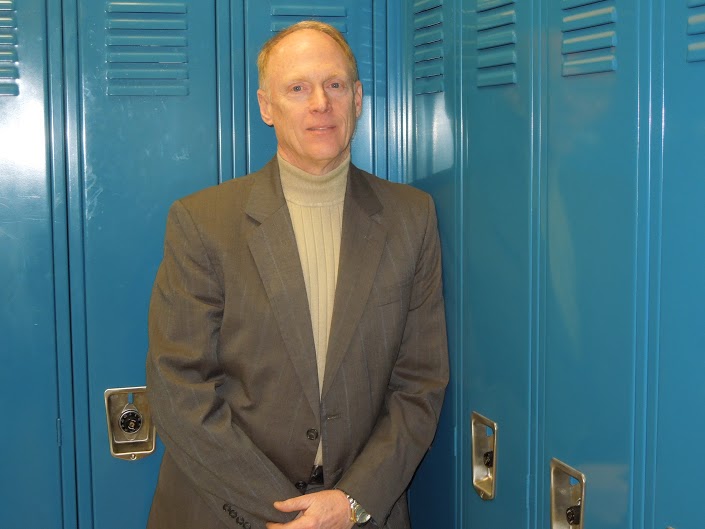It’s all about family for one State Champ
Tim Hughes apologizes for running a few minutes late.
He’s coordinating the donation of $10 to a family that needs gas to get to work, and fixing a computer glitch in the building. Being a superintendent of a one-building, K-12 school district means wearing a lot of hats.
“We make it work,” Hughes said. “Sometimes we don’t know how, but we make it work.”
Ashley Community Schools makes it work better than almost any school district in Michigan. Ashley, a tiny, rural district 40 miles north of Lansing, is the fourth-ranked school district in the state among Bridge Magazine’s Academic State Champs for 2014.
See how your district measures up
Bridge’s ranking system adjusts a district’s raw test scores to factor in the income of students, based on the percentage of students eligible for free and reduced lunch. The adjusted ranking is a measure of how a district’s students perform academically compared with students in districts with similar income levels around the state, an acknowledgement of the huge impact poverty can have on student performance. You could say it’s an award not for high achievement, but for overachievement.
Under the Academic State Champs formula, Ashley is an academic superstar. The district ranked No. 3 in the state among rural school districts, No. 2 among low-income districts (where at least 80 percent of students qualify for free or reduced lunch), and No. 1 in its region. The district’s high school students ranked No. 1 overall; middle school students were No. 4.
The numbers show Ashley is outshining most peer districts. Among sixth graders, for instance, 85 percent were proficient in reading last school year (2013-14). That placed Ashley 10th among 94 districts in the state with similar income levels. In social studies, only one other low-income school did better than Ashley.
“This validates that we’re taking kids where they are and moving them forward,” Hughes said.
See the Top 10 high-poverty, low-poverty, rural and charter districts in the state.
Tough times, tougher kids
Ashley is a close-knit, rural farming community whose fortunes have declined in recent years. Some families have moved to find jobs, and others are struggling. The district receives the minimum state allotment of $7,126 per student, and has run a deficit for three years in a row.
Almost 90 percent of the district’s 293 kids are eligible for free or reduced lunch. That’s higher than school districts known for crushing poverty, including Detroit, Flint, Benton Harbor and Saginaw.
All students in the district are housed in one building, across the street from a storage unit facility and a snow-covered field. The school library doubles as the community’s public library.
There are between 20 and 25 students per grade. In the high school hallway, the entire freshman class moves in a pack between periods from math to English to social studies.
“There are students who may have me in 12 to 14 classes before they graduate,” said Dana Bishop, who teaches social studies in grades 8-12.
At first blush, the district’s student test scores don’t appear extraordinary. Just 44 percent of seventh graders were proficient in math on the 2013-14 MEAP test; 60 percent were proficient in reading. Among 11th graders last year, just one student was deemed “college ready” in all subject categories on the ACT. Yet the school is an academic superstar when compared with other low-income school districts across the state.
That success, measured in taking kids where they are and moving them as far as possible academically, takes place despite the limitations of a cash-short, one-building district.
Class choices are slim; chemistry is offered one year, physics the next. Spanish is offered as the school’s sole foreign language, but the Spanish teacher quit and now Hughes is scrambling to hire a replacement.
But the small size that creates challenges is also the school’s strength, says Brandee West, language arts teacher for grades 8-12.
“I know them, I know their parents, I know their cousins. I know if Grandma passed away last week and I need to give them space.” ‒ Dana Bishop, Ashley social studies teacher
“It’s personal here,” West said. “We have the same kids years in a row, so by the time they’re seniors, we know their interests and adjust lesson plans to fit.”
“I have a great rapport with the kids,” said Bishop, the social studies teacher. “I know them, I know their parents, I know their cousins. I know if Grandma passed away last week and I need to give them space.
“We’re family,” Bishop said. “When I announced I was pregnant, the students said, ‘but you already have 90 kids.’”
“The teachers go out of their way to understand what is going on with a student,” said senior Paige Mireles, who plans to study criminology at Grand Valley State University. “Everyone knows everyone.”
Mentoring across grades
That closeness creates a culture of caring that sparks academic achievement. Older students can routinely be seen in hallways helping younger students with homework. “We support each other because we know each other so well,” explained senior Zachary Blackburn.
Parents, many of whom went to school with Ashley teachers, are comfortable walking into the school to talk about their kids’ education. Students work to meet the expectations of their teachers because “they don’t want to disappoint us,” Bishop said.
Those expectations revolve around getting a greater share of the farm community’s teens into some type of post-secondary education. That may not always mean a Big Ten university, but more kids are going to community college and technical schools, and that’s a step up the economic ladder.
“The students themselves, they’ve seen their parents struggling, and they want more,” said counselor Jen Jason. “They’re determined.”
“Some say, ‘I’m going to be the first in my family to graduate high school.’ I say, ‘Well, then how about community college?’” said Bishop. “I grew up in town smaller than Ashley (Oakley, population 290), and I went to college and went to Europe. I say, ‘I’m the same as you, it can happen. If I can do it, so can you.’”
There’s a can-do attitude at Ashley, from the inspirational sayings painted on the hallway walls, to sports, where Ashley is the smallest school in the state to play 11-man football. This fall, there were 28 players on the football team, from freshmen to seniors. The got walloped in a few games, but they finished the season with three victories.
“Our expectations for them (on the football field and in the classroom) are high,” said Bryan Melville, a high school English teacher and former factory worker who coaches Ashley’s middle school football team for free because there’s no money in the budget. “We’re going to do the best we can,” Melville said. “We’re never going to give up.
Michigan Education Watch
Michigan Education Watch is made possible by generous financial support from:
Subscribe to Michigan Education Watch
See what new members are saying about why they donated to Bridge Michigan:
- “In order for this information to be accurate and unbiased it must be underwritten by its readers, not by special interests.” - Larry S.
- “Not many other media sources report on the topics Bridge does.” - Susan B.
- “Your journalism is outstanding and rare these days.” - Mark S.
If you want to ensure the future of nonpartisan, nonprofit Michigan journalism, please become a member today. You, too, will be asked why you donated and maybe we'll feature your quote next time!


 Say hi to the entire high school at Ashley Community Schools, where the high school program is ranked No. 1 among all districts in the 2014 Academic State Champs. While their raw test scores are average, the students here overachieve compared with students at other low-income districts around the state (photo by Ron French).
Say hi to the entire high school at Ashley Community Schools, where the high school program is ranked No. 1 among all districts in the 2014 Academic State Champs. While their raw test scores are average, the students here overachieve compared with students at other low-income districts around the state (photo by Ron French). Ashley Superintendent Tim Hughes says the district’s small size – all grades are in one building – creates a communal culture, with older students helping younger schoolmates. (photo by Ron French)
Ashley Superintendent Tim Hughes says the district’s small size – all grades are in one building – creates a communal culture, with older students helping younger schoolmates. (photo by Ron French)
